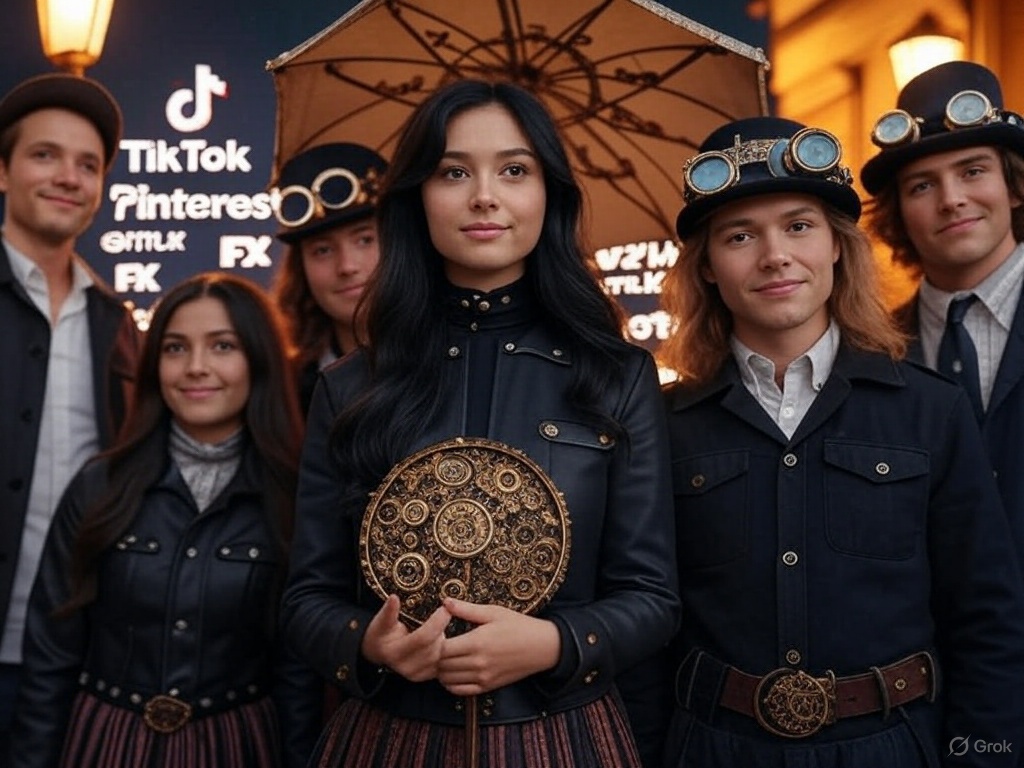Fandoms are more than just fan bases — they’re passionate communities that drive cultural conversations and shape the success of entertainment projects.
In 2025, companies like TikTok, Pinterest, FX, Netflix, Sony Pictures, and Hulu are doubling down on understanding and engaging these groups. Here are the key insights from their experiences, showcasing how they navigate the complex, rewarding world of fandoms.
TikTok: Algorithms Amplify Fandoms Beyond Expectations
 TikTok has dedicated teams studying specific fandoms and tracking how trends spread across the U.S. and globally. Their findings reveal that successful fandoms aren’t bound by geography or social groups but by shared interests.
TikTok has dedicated teams studying specific fandoms and tracking how trends spread across the U.S. and globally. Their findings reveal that successful fandoms aren’t bound by geography or social groups but by shared interests.
High-quality comedic content, for example, can organically find its audience through TikTok’s algorithm, which excels at connecting niche content with the right viewers.
What’s more intriguing is how the algorithm transcends traditional marketing cohorts. A horror movie clip might spark not just spooky fan content but also humorous or even culinary creations — like a user crafting a dish inspired by a TV series.
 This unexpected cross-pollination can pull in entirely new audiences, such as food enthusiasts, who might not have been the original target. TikTok’s ability to amplify fandoms in unpredictable ways highlights the platform’s power to create cultural moments that ripple far beyond initial expectations.
This unexpected cross-pollination can pull in entirely new audiences, such as food enthusiasts, who might not have been the original target. TikTok’s ability to amplify fandoms in unpredictable ways highlights the platform’s power to create cultural moments that ripple far beyond initial expectations.
Also read: TikTok Surpasses Twitch to Become the Second Most-Watched Livestreaming Platform in Q1 2025
Pinterest: A Goldmine for Fandom Insights and Trend Prediction
 Pinterest remains a go-to platform in the U.S. for life planning—weddings, birthdays, seasonal fashion, and more. But its value extends far beyond user boards. The platform is a treasure trove of insights for brands, offering predictive data on emerging trends.
Pinterest remains a go-to platform in the U.S. for life planning—weddings, birthdays, seasonal fashion, and more. But its value extends far beyond user boards. The platform is a treasure trove of insights for brands, offering predictive data on emerging trends.
By analyzing what users pin, Pinterest can forecast what’s next in fandom culture, whether it’s a surge in gothic aesthetics inspired by Wednesday or samurai-inspired decor following Hulu’s Shogun.
For marketers, Pinterest isn’t just a planning tool—it’s a window into the desires and aspirations of fandoms, making it an essential resource for crafting campaigns that resonate.
Also read: Pinterest Ban Wave Sparks Outrage: A Reminder That Your Content Isn’t Truly Yours
FX: Fandoms as Religions with Rules to Follow
 The team at FX likens joining a fandom to adopting a religion: there are sacred rules and commandments that must be respected. When working with fandoms, FX emphasizes careful dialogue with both creators and fans.
The team at FX likens joining a fandom to adopting a religion: there are sacred rules and commandments that must be respected. When working with fandoms, FX emphasizes careful dialogue with both creators and fans.
Their marketing philosophy focuses on extremes—content that plays it safe or sits in the middle rarely makes an impact. Currently, FX is tackling the Alien franchise, a fandom with diverse subgroups. Some fans are drawn to the intellectual depth, others to the horror elements, and each group has its own expectations.
FX’s approach underscores the importance of understanding these nuances to engage each segment authentically, ensuring marketing efforts honor the fandom’s distinct identities.
Netflix: Fandoms Drive Cultural Conversations
Netflix is gearing up for a “fandom year” in 2025, with major releases like the finales of Squid Game and Stranger Things, alongside Wednesday Season 2. The streaming giant has identified a key pattern: if a show doesn’t gain traction in Brazil, it’s unlikely to achieve global success.
 Brazil has become a testing ground for Netflix, and early success there often predicts worldwide popularity. For instance, Cobra Kai, set to release on May 30, 2025, has already captured Brazilian audiences, setting the stage for strong global numbers.
Brazil has become a testing ground for Netflix, and early success there often predicts worldwide popularity. For instance, Cobra Kai, set to release on May 30, 2025, has already captured Brazilian audiences, setting the stage for strong global numbers.
Beyond viewership, Netflix’s primary marketing metric is cultural impact—how much a project sparks discussion across platforms and communities. The team constantly tracks mentions of their shows and brand, aiming to maximize buzz.
This focus on cultural conversation reflects Netflix’s understanding that fandoms thrive on shared excitement, and a show’s legacy often hinges on how deeply it embeds itself in the cultural zeitgeist.
Also read: The Battle for Creators: Netflix, Peacock, and Disney Chase YouTube Stars
Sony Pictures: Balancing Legacy and New Fans with Care
Sony Pictures emphasizes the emotional connection fans have with their favorite projects, urging marketers to approach fandoms with the same reverence fans feel.
 The team is currently working on "28 Years Later", a sequel to a beloved film released decades ago. Their biggest challenge is twofold: retaining the loyalty of longtime fans while introducing the universe to a new generation in a way that makes them feel instantly included.
The team is currently working on "28 Years Later", a sequel to a beloved film released decades ago. Their biggest challenge is twofold: retaining the loyalty of longtime fans while introducing the universe to a new generation in a way that makes them feel instantly included.
A Sony spokesperson described this balancing act as “walking a tightrope,” but the reward is immense — seeing positive reactions from dedicated fans is a unique thrill for marketers and producers.
This delicate approach highlights the need for sensitivity and authenticity when working with established fandoms.
Hulu: Navigating Challenges with Shogun
 Hulu’s Shogun presented a complex case for its marketing team. Set in 1600 Japan with Japanese subtitles, the show carried significant risks—its historical setting and language barriers didn’t guarantee mainstream appeal.
Hulu’s Shogun presented a complex case for its marketing team. Set in 1600 Japan with Japanese subtitles, the show carried significant risks—its historical setting and language barriers didn’t guarantee mainstream appeal.
The team was both inspired and intimidated by the project. To market Shogun, they leaned into themes of samurai culture, warfare, human relationships, and broader Japanese traditions, aiming to make the story accessible and compelling.
The show’s creator provided a 500-page “bible” detailing the world of Shogun, which became the team’s go-to guide.
This meticulous preparation paid off, as Shogun resonated with audiences, proving that even challenging content can find its fandom with the right approach.
Key Takeaways for Working with Fandoms
 Across these platforms and studios, a few universal lessons emerge:
Across these platforms and studios, a few universal lessons emerge:
- Fandoms Are Global and Interest-Driven: TikTok’s insights show that fandoms thrive on shared passions, not demographics, and algorithms can amplify their reach in unexpected ways.
- Data Is Power: Platforms like Pinterest and Netflix leverage data to predict trends and measure cultural impact, giving marketers a roadmap to engage fandoms effectively.
- Respect the Rules: FX and Sony Pictures highlight the importance of understanding a fandom’s unique dynamics — treating it with the care and respect of a deeply held belief system.
- Balance Legacy and Growth: Sony’s work on 28 Years Later underscores the challenge of honoring existing fans while welcoming new ones, a delicate but rewarding endeavor.
- Cultural Conversations Matter: Netflix and Hulu aim to spark discussions, recognizing that a fandom’s strength lies in its ability to drive buzz and connect communities.
Working with fandoms is both an art and a science, requiring deep empathy, strategic insight, and a willingness to adapt. As these companies demonstrate, getting it right can create lasting cultural moments—and a fiercely loyal fan base that propels projects to new heights.






